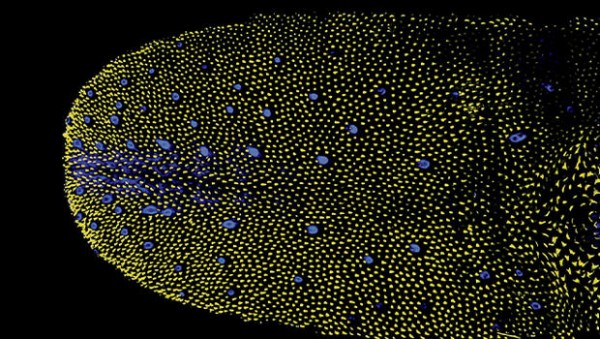For the First Time, Scientists Observe How Taste Cells Work
| Marco Foronda | | Apr 24, 2015 08:37 PM EDT |
(Photo : S. Lee, S. Yun, M. Choi) Tongue, illuminated by two-photon excitation. Taste buds are blue, amongst the yellow papillae.
A special microscopic camera has revealed to scientists the taste bud process in action for the first time in real time.
A worldwide group of researchers captured the tasting sensation in real time with the use of a special camera that focused on a single tongue cell of a mouse. Scientists watched the performance as it was accelerated by various tastes.
Like Us on Facebook
Witnessing the tasting process for the first time up close and personal led scientists to discovering that tongue cells develop molecules in blood vessels adjacent to them, and also those in closer contact with food.
The tongue cells were illuminated by an infrared light in the microscopic camera. The technology called "intravital multiphoton microscopy" has the ability to make different components of the cell become fluorescent.
Intravital multipohoton microscopy is also able to detail the blood vessels beneath the cell surface with a size of some 240 microns.
With these new findings, scientists are hopeful this technology can also be paired with brain imaging. They hope the technology can allow them to see how the full system works in real time.
"We've watched live taste cells capture and process molecules with different tastes," said Steve Lee, an engineer specialized in biomedical at the Australian National University. "Until we can simultaneously capture both the neurological and physiological events, we can't fully unravel the logic behind taste," Lee stated.
Previous studies examined the relation between the tongue and the brain. Scientists have recorded 2,000 and more different taste cells able to distinguish each of five tastes: sweet, bitter, salty, umami and sour.
Understanding the complex connections between cell clusters and taste buds is critical since each taste bud consists of multiple cells.
"With this new imaging tool we have shown that each taste bud contains taste cells for different tastes", said Seok-Hyun Yun, a Harvard Medical School professor.
TagsScientists Capture How Taste Cells Work, taste buds, taste cells, Tongue, umami, cells study, tasting sensation
©2015 Chinatopix All rights reserved. Do not reproduce without permission
EDITOR'S PICKS
-

Did the Trump administration just announce plans for a trade war with ‘hostile’ China and Russia?
-

US Senate passes Taiwan travel bill slammed by China
-

As Yan Sihong’s family grieves, here are other Chinese students who went missing abroad. Some have never been found
-

Beijing blasts Western critics who ‘smear China’ with the term sharp power
-

China Envoy Seeks to Defuse Tensions With U.S. as a Trade War Brews
-

Singapore's Deputy PM Provides Bitcoin Vote of Confidence Amid China's Blanket Bans
-

China warns investors over risks in overseas virtual currency trading
-

Chinese government most trustworthy: survey
-

Kashima Antlers On Course For Back-To-Back Titles
MOST POPULAR
LATEST NEWS
Zhou Yongkang: China's Former Security Chief Sentenced to Life in Prison

China's former Chief of the Ministry of Public Security, Zhou Yongkang, has been given a life sentence after he was found guilty of abusing his office, bribery and deliberately ... Full Article
TRENDING STORY

China Pork Prices Expected to Stabilize As The Supplies Recover

Elephone P9000 Smartphone is now on Sale on Amazon India

There's a Big Chance Cliffhangers Won't Still Be Resolved When Grey's Anatomy Season 13 Returns

Supreme Court Ruled on Samsung vs Apple Dispute for Patent Infringement

Microsoft Surface Pro 5 Rumors and Release Date: What is the Latest?










